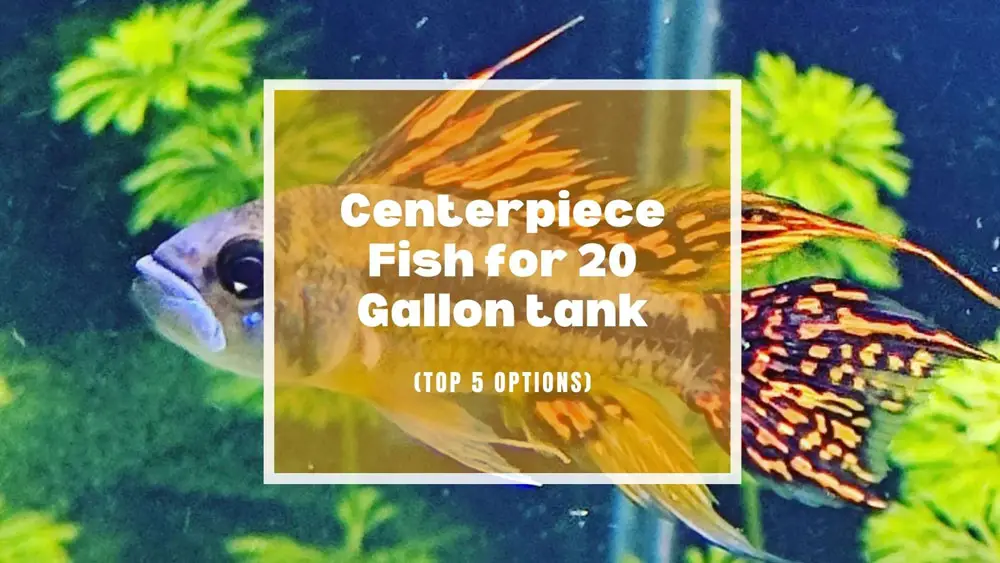A 20 gallons fish tank is perfect for those who want to add a little bit of life to their home without going overboard. They’re big enough to house a nice stock of fish, some plants, and a variety of other aquatic creatures but small enough to fit on most shelves and stand without taking up too much space.
If you are in the market and looking to add a centerpiece fish for your 20-gallon tank, this list is for you! We have the top 15 fish that are sure to make your tank stand out and wow your friends and family. From vibrant gouramis to unique rainbowfish, there is sure to be something for everyone.
20 Gallon Fish Tank Basics
Let’s start with the basics of a 20-gallon fish tank.
| Tank Size | L x W x H | Empty Weight | Filled Weight |
|---|---|---|---|
| 20-gallon (high) | 24″ x 12″ x 16″ | 25 lbs. | 225 lbs. |
| 20-gallon (long) | 30″ x 12″ x 12″ | 25 lbs. | 225 lbs. |
The dimensions are important to take into consideration when stocking your fish tank. Not only does it affect the number of fish you can have, but the type of fish as well.
Although personal preference comes into play, a longer tank is often better than a taller one because it provides more surface area and offers more decoration options.
Another thing to consider is the weight of the tank. A full 20-gallon fish tank can be heavy, so make sure it’s placed on a sturdy surface that can support the weight.
Now that we’ve gone over the basics of a 20-gallon fish tank let’s talk about stocking.
How to Choose A Centerpiece Fish to Stock
Before you head to your local fish store or order anything online, you need to ask yourself a few fundamental questions. These will help determine which centerpiece show fish is best for your 20-gallon tank.
- How big is the fish going to get?
- Is the fish territorial and aggressive?
- Is it a fin nipper?
- Does it eat live plants?
- Does it dig in the substrate?
- What are the required water parameters? (pH, hardness, temperature, etc.)
- Is it a gregarious or solitary fish?
- Is it wild-caught or captive-bred?
- How much does it cost to buy?
Top 15 Centerpiece Fish for 20 Gallon tank
Gouramis
Looking for a fish to be the centerpiece of your 20-gallon tank? Look no further than Gouramis! These brightly colored, graceful swimmers will bring life and energy to your aquarium.
Gourami is labyrinth fish, meaning they have a unique organ that allows them to breathe air directly from the surface. That’s why you’ll likely find them spending a good amount of time at the middle and top levels of your aquarium.
However, some species grow large and do not go well with others. Here are some of the small ones available.
#1: Honey Gouramis (Trichogaster chuna)
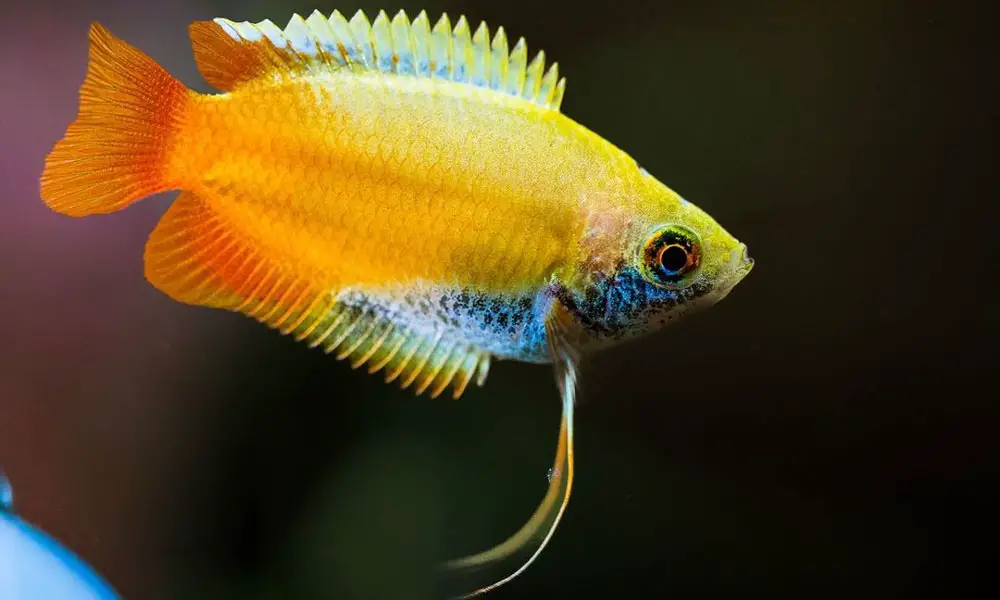
Our #1 top pick of Gouramis for a 20-gallon tank is the Honey Gourami. Like the popular betta fish, this species has very striking and bright coloring and makes bubble nests to help rear its young. Plus, they are quite peaceful fish that will get along with everyone.
As one of the smaller gouramis available in the hobby, the Honey Gourami will typically max out at 2 inches (5 cm), while dwarf gourami can grow up to 3 inches (8 cm) in size. This species prefers to stick together, so a small group of 3 Honey Gouramis would do better in a 20-gallon aquarium.
| Scientific Name: | Trichogaster chuna |
| Common Name: | Honey Gourami |
| Origin: | India and Bangladesh |
| Family: | Osphronemidae |
| Size: | 2 inches (5 cm) |
| Social: | Peaceful |
| Care: | Easy |
| Lifespan: | 4 years |
| pH: | 6 to 8 |
| Temperature: | 75 to 82 F (24 to 28 C) |
| KH: | 4 – 15 dKH |
| Diet: | Omnivore |
| How Many Fish in A 20 Gallon Tank? | 3 |
#2 Dwarf Gouramis (Trichogaster Ialius)
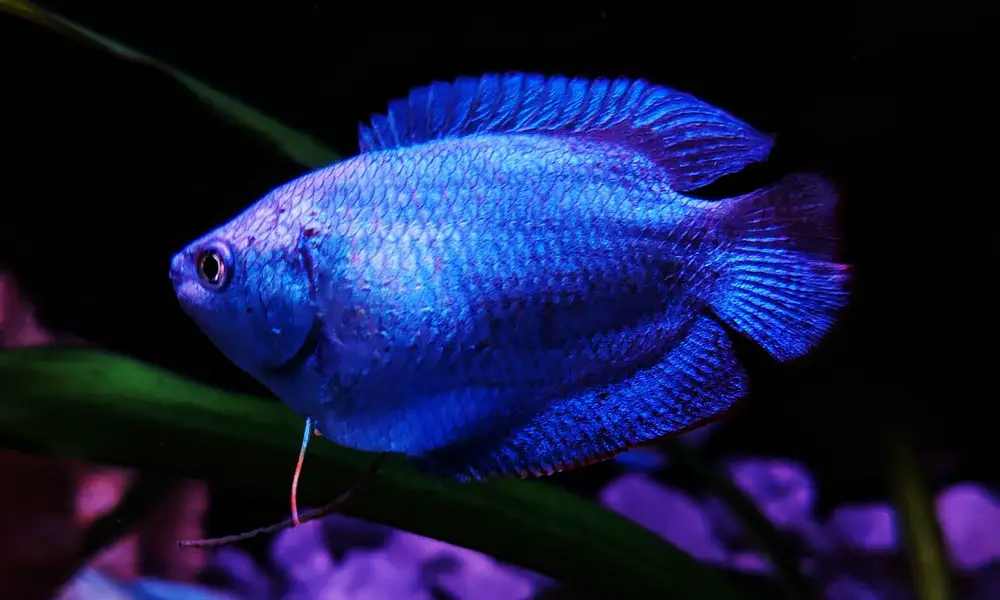
Dwarf gouramis are a popular alternative to Honey Gouramis and bettas as there are a greater number of color morphs sold in pet stores.
However, they tend to be feisty and can be quarrelsome with others. So, the best setup for 20-gallon freshwater aquariums, in our experience, is to have just one male as a centerpiece fish with other community fish of similar sizes in a well-planted tank, such as most bottom dwellers, dwarf cichlids, and small tetras.
Because of their popularity in the trade in recent years, a deadly virus known as Dwarf Gourami Iridovirus (DGIV) has been reported in some strains of dwarf gouramis imported from Southeast Asia, so make sure to purchase healthy-looking specimens from a reputable dealer.
| Scientific Name: | Trichogaster Ialius |
| Common Name: | Dwarf gourami, flame gourami, powder blue gourami, red gourami, sunset gourami |
| Origin: | India, Bengal, Assam, and Bangladesh |
| Family: | Belontiidae |
| Size: | 3 inches (8 cm) |
| Social: | Peaceful |
| Care: | Intermediate |
| Lifespan: | 4 years |
| pH: | 6.0 to 7.5 |
| Temperature: | 72 to 82 F (22 to 28 C) |
| KH: | 4 – 10 dKH |
| Diet: | Omnivore |
| How Many Fish in A 20 Gallon Tank? | One Male |
#3 Chocolate Gourami (Sphaerichthys osphromenoides)
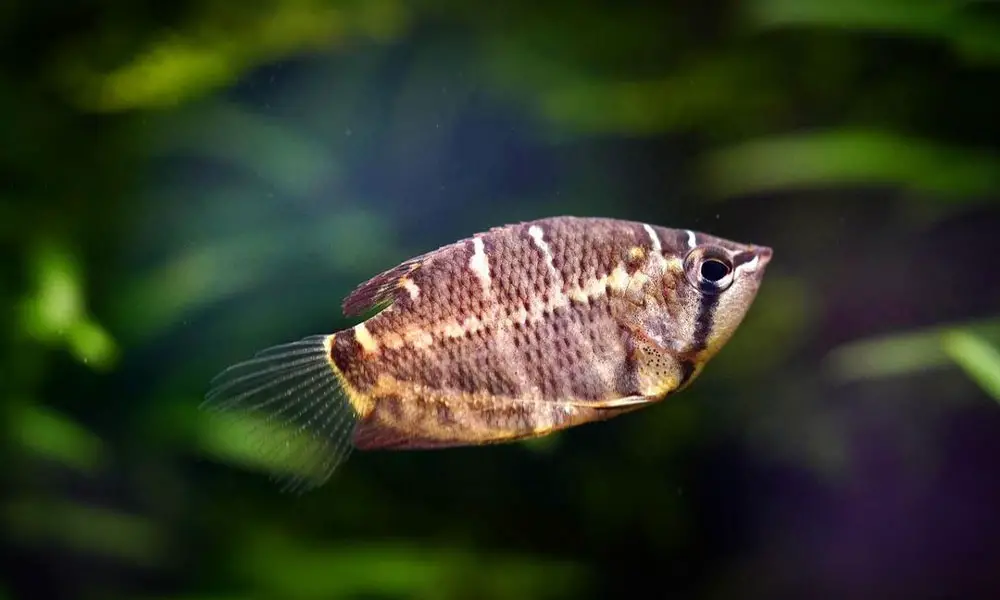
If you are an old hand at fishkeeping and are ready to experiment a bit, then the Chocolate Gourami is definitely a fish you should consider.
On the one hand, they are more sensitive to water conditions. In their natural habitat, they generally live in peat swamps and blackwater streams where the water is usually acidic and low in minerals.
On the other hand, this 2.5-inch (6.4 cm) gourami is a somewhat shy fish and usually only tolerates its own kind and other species similar in size and require the same water conditions and care.
As for the 20-gallon tank, a pair or small groups of three individuals or more make an excellent centerpiece group in your aquarium!
| Scientific Name: | Sphaerichthys osphromenoides |
| Common Name: | Chocolate gourami |
| Origin: | Borneo, Malacca, Malay Peninsula, Sumatra |
| Family: | Osphronemidae |
| Size: | 2.5-inch (6.4 cm) |
| Social: | Peaceful |
| Care: | Difficult |
| Lifespan: | 5 years |
| pH: | 4.0 to 6.0 |
| Temperature: | 75 to 86 F (25 to 30 C) |
| KH: | 0.5 – 6 dKH |
| Diet: | Omnivore |
| How Many Fish in A 20 Gallon Tank? | A pair/3 |
#4 Blue Gourami (Trichogaster trichopterus)
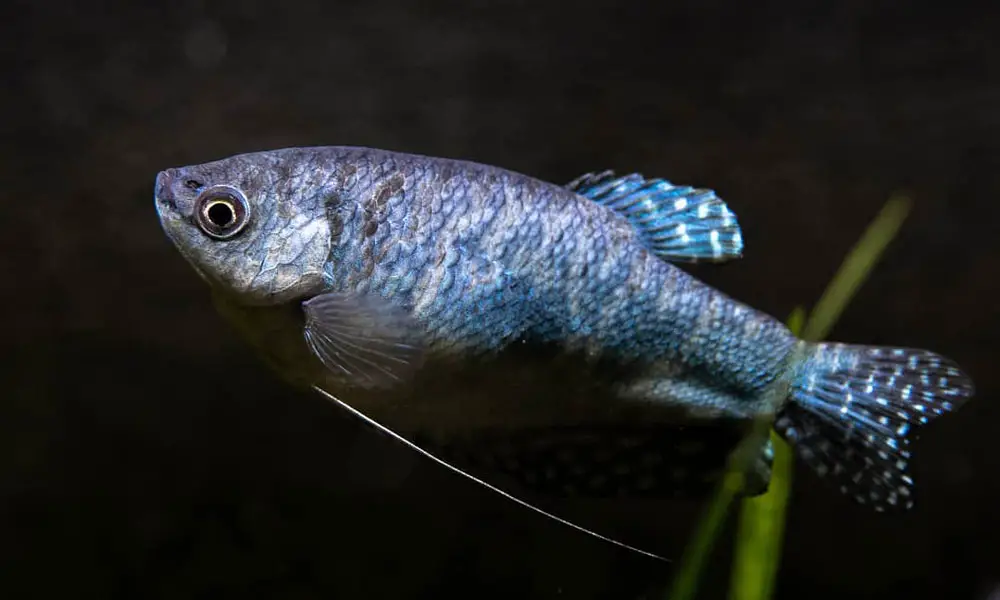
This underrated, hardiest cousin of the Dwarf Gouramis is the all-time favorite that we find ourselves recommending over and over again.
Their silvery-blue hue is where they get their name, which is a natural variation of the usual lavender gourami. The blue color changes considerably when their emotions change, especially during spawning.
Young Blue Gouramis can be kept in 15 to 20 gallons tanks, but as they mature and reach adulthood, tanks of 33 gallons or more will be required. Because the males may be territorial, it’s recommended that only one male be kept per tank.
| Scientific Name: | Trichogaster trichopterus |
| Common Name: | Blue gourami, opaline gourami, cosby gourami, giant gourami, siamese gourami |
| Origin: | Asia |
| Family: | Osphronemidae |
| Size: | 4 inches (10 cm) |
| Social: | Peaceful |
| Care: | Easy |
| Lifespan: | 5 years |
| pH: | 6 to 8 |
| Temperature: | 74 to 82 F (25 to 28 C) |
| KH: | 5 – 35 dKH |
| Diet: | Omnivore |
| How Many Fish in A 20 Gallon Tank? | One Male |
#5 Moonlight Gourami (Trichogaster microlepis)
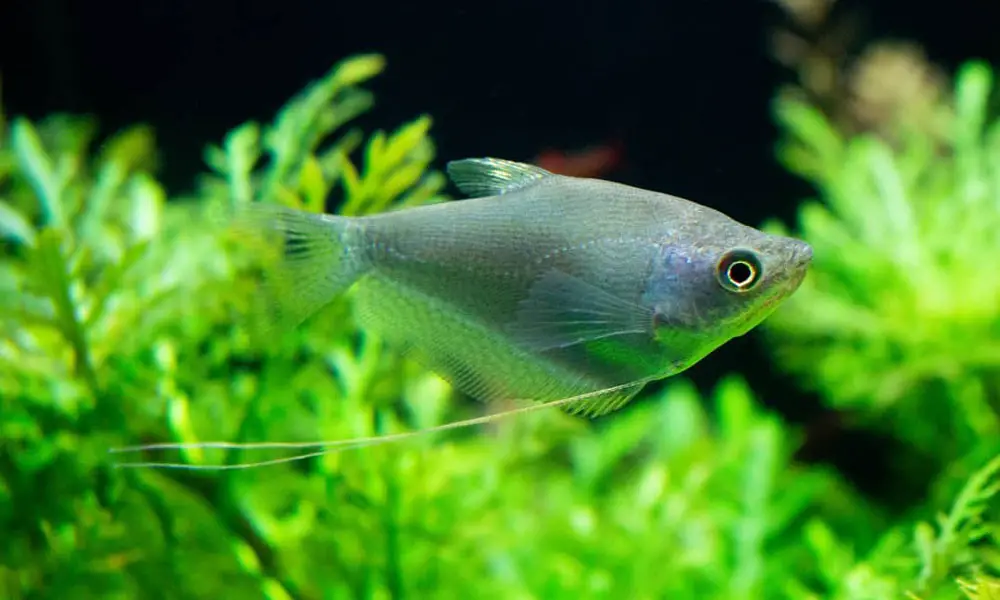
The common name Moonlight Gouramis is derived from its silver-colored body with a greenish hue on its fins resembling the soft glow of moonlight.
Like its cousin Blue Gouramis, this species is not quite a small fish since it can reach up to 5 inches (13 cm) long, but are rather timid, so a single Blue Gouramis with other peaceful community fish in a planted 20-gallon is a great setup.
| Scientific Name: | Trichogaster microlepis |
| Common Name: | Moonlight Gourami, moonbeam gourami |
| Origin: | Thailand, Cambodia |
| Family: | Belontiidae |
| Size: | 5 inches (13 cm) |
| Social: | Peaceful |
| Care: | Intermediate |
| Lifespan: | 6 years |
| pH: | 6 to 7 |
| Temperature: | 79 to 86 F (26 to 30 C) |
| KH: | 2 – 25 dKH |
| Diet: | Omnivore |
| How Many Fish in A 20 Gallon Tank? | One Male |
#6 Pearl Gourami (Trichogaster leeri)
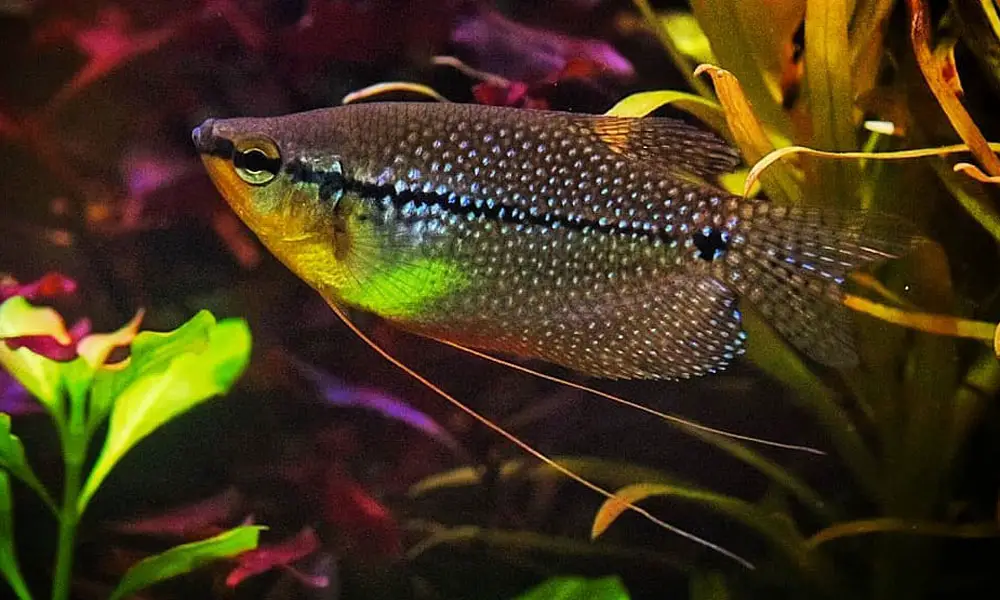
Our last gourami species on this list is Pearl Gourami. Their body is brownish silver in color, covered in thin pearl-like flecks with a distinct stripe running from the head through to the end of the caudal fin, given its name.
Pearl Gouramis are also quite hardy and easy to care for. Because the guys can be a bit larger and reach about 4.7 inches (12 cm) in length, aim for a single male or a pair in a 20-gallon tank with a background of green plants.
| Scientific Name: | Trichopodus leerii |
| Common Name: | Pearl gourami, mosaic gourami, lace gourami, diamond gourami, leeri gourami |
| Origin: | Malaysia, Sumatra, Borneo, and Thailand |
| Family: | Osphronemidae |
| Size: | 4.7 inches (12 cm) |
| Social: | Peaceful |
| Care: | Easy |
| Lifespan: | 8 years |
| pH: | 5.5 to 7.5 |
| Temperature: | 77 to 82 F (25 to 28 C) |
| KH: | 2 – 30 dKH |
| Diet: | Omnivore |
| How Many Fish in A 20 Gallon Tank? | One Male/A pair |
#7 Bolivian Ram (Mikrogeophagus altispinosus)
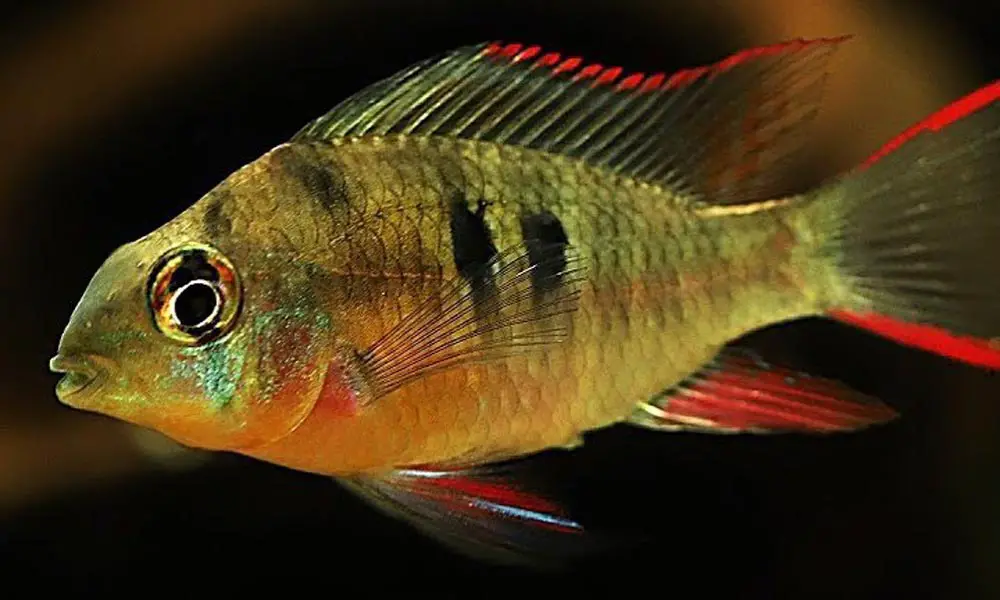
For those looking for a centerpiece South American Cichlid that is both stunning and relatively easy to care for, the Bolivian Ram is a great option.
Bolivian Rams have an elongated oval-shaped body, the main coloration is tan or silver, and their extended and showy rayed fins are decorated with bright red edging. Sometimes, faint dark bars can be seen running across their body. Males often have long filaments on their fins.
Fully grown, Bolivian rams will reach a length of 3.1 inches (8cm); males grow larger than females but usually don’t reach 3.5 inches at all.
Bolivian Rams are peaceful cichlids. In a 20 gallons tank, you can keep a pair or trio with other small schooling fish and bottom-dwellers that share similar water parameters in a community South American cichlid setup.
| Scientific Name: | Mikrogeophagus altispinosus |
| Common Name: | Bolivian Ram, Butterfly Ram, Red Ram, Bolivian butterfly, Bolivian ram cichlid, and ruby crown cichlid |
| Origin: | Brazil and Bolivia |
| Family: | Cichlidae |
| Size: | 3 inches (7.6 cm) |
| Social: | Peaceful |
| Care: | Easy |
| Lifespan: | 4 years |
| pH: | 5.5 to 7.5 |
| Temperature: | 72 to 79 F (22 to 26 C) |
| KH: | 0 – 10 dKH |
| Diet: | Omnivore |
| How Many Fish in A 20 Gallon Tank? | A pair or trio |
#8 Ram Cichlid (Mikrogeophagus ramirezi)
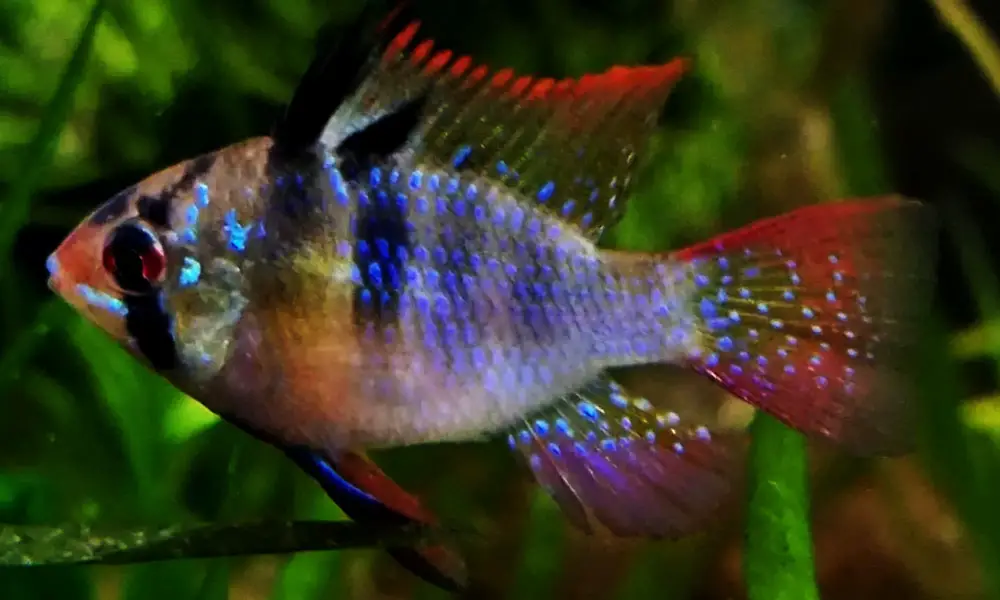
If you can’t find Bolivian Rams in your LFS, another great centerpiece fish for a 20 gallons freshwater aquarium is its cousin, Ram Cichlid (Mikrogeophagus ramirezi), which is more widely available.
In the wild, this small freshwater fish is endemic to the Orinoco River basin and lives in slow-flowing streams and flooded forest areas with heavy aquatic plants.
Wild-caught specimens are more colorful than tank-bred ones. They have a beautiful gold or silver body with numerous black markings. Red or orange is usually found on the tips of the fins.
As their name suggests, its body is usually accompanied by a contrasting reflective electric blue stripe, giving the fish a flashy and attractive appearance.
Ram cichlids are small, laterally compressed freshwater fish that grow about 2 to 3 inches long. Due to its small adult size and relatively peaceful nature, it’s not recommended to be kept with these aggressive cichlid species.
In the wild, they are found in large groups, so it’s best to keep them in pairs or trio with other small and peaceful fish in your 20-gallon aquarium.
| Scientific Name: | Mikrogeophagus ramirezi |
| Common Name: | Ram, blue ram, dwarf butterfly cichlid, butterfly cichlid, German blue ram, and Ramirez |
| Origin: | Orinoco River basin, South America |
| Family: | Cichlidae |
| Size: | 3 inches (7.6 cm) |
| Social: | Peaceful |
| Care: | Advanced |
| Lifespan: | 2 to 3 years |
| pH: | 5.0 to 7.0 |
| Temperature: | 74 to 82F (23 to 28C) |
| KH: | 0 – 10 dKH |
| Diet: | Omnivore |
| How Many Fish in A 20 Gallon Tank? | A pair or trio |
#9 Apistogramma Dwarf Cichlids (Apistogramma sp.)
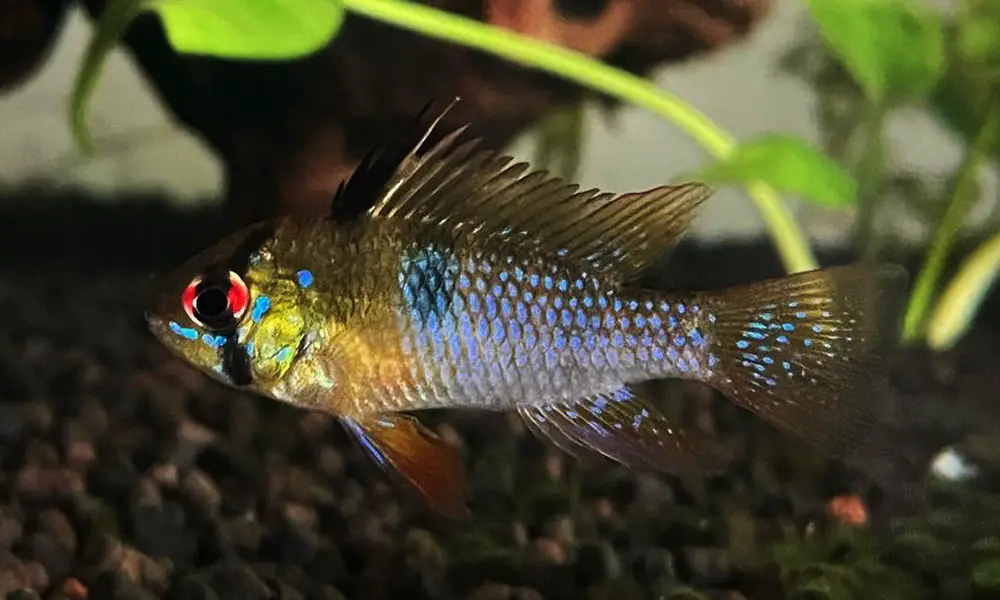
Any small-sized Cichlids list would not be complete without at least one of the Apistogramma Dwarf Cichlids.
Apistogramma is a large genus of cichlids found in South America, with more than 93 species described to date. They’re found in the western Amazon Basin and Orinoco Basin, where they inhabit clear, black and white shallower water.
These popular aquarium fish are well known for their bright colors and varied personalities. Unfortunately, some Apistos are not for newbies since they are very sensitive to water quality conditions. As a potential owner, you must be devoted to providing the best care for your fish.
Apistos can grow to be 0.8 to 3 inches long, depending on the species. They are typically brightly colored, with males often being more colorful than females.
The most popular beginner-friendly Apistos for a 20 gallons aquarium are A. cacatuoides (Cockatoo cichlid) and Apistogramma borellii (Umbrella Cichlid). These two species are relatively peaceful and adaptable.
| Scientific Name: | Apistogramma spp. |
| Common Name: | Apistogramma Dwarf Cichlids |
| Origin: | South America |
| Family: | Cichlidae |
| Size: | 0.8 to 3 inches |
| Social: | Various (depending on the species) |
| Care: | Easy or Advanced |
| Lifespan: | 5 to 8 years |
| pH: | 5.0 to 7.0 |
| Temperature: | 72 to 86 F (22 to 30 C) |
| KH: | 2 – 15 dKH |
| Diet: | Omnivore |
| How Many Fish in A 20 Gallon Tank? | A pair or a small group |
#10 Kribs (Pelvicachromis pulcher)
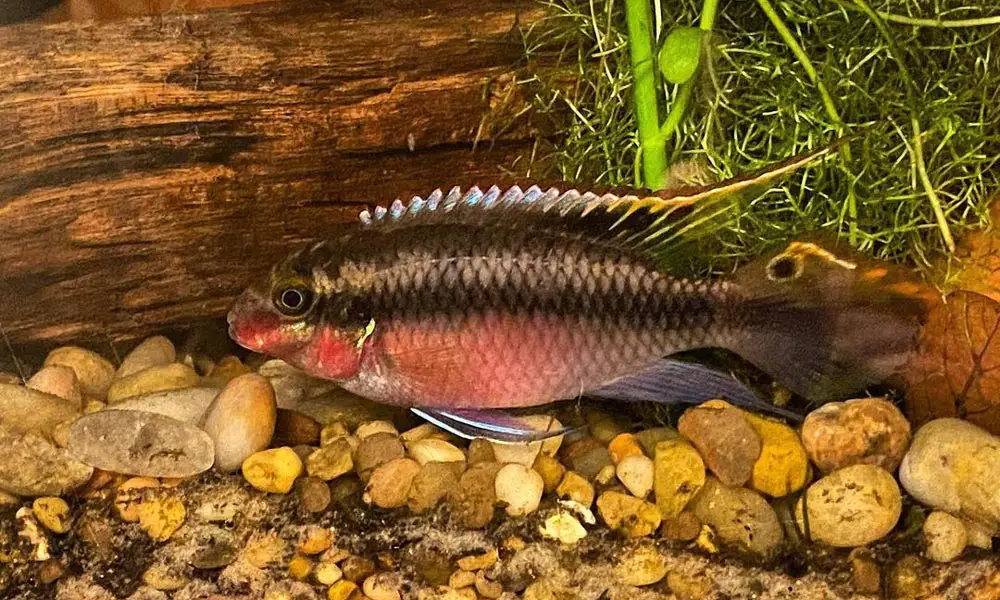
Now we have the famous South American Dwarf Cichlids, but it’s not the only dwarf cichlid out there; The West African Dwarf Cichlids, Kribensis (Pelvicachromis pulcher), are well known by cichlid keepers.
Being some of the first West African cichlids to be introduced into the aquarium trade, they have been captive-bred for many generations and now come in various colors and patterns. The most common color morphs are yellow and red, in addition to the line-bred albino variety.
Kribs are small cichlids that males can grow to be about 4 inches long while females stay a bit smaller at about 2.5 inches. They are found in blackwater streams with acidic and soft water conditions in the wild.
Given their small size and peaceful temperament, they make great tank mates for other small community fish such as danios, cory cats, plecos, and barbs. However, these fish tend to be fin nippers, so you should not keep them with Angels unless you have a larger tank.
In a 20-gallon aquarium, a breeding pair of Kribs would be a good centerpiece fish. If you want to keep more than a pair, then you should consider getting a larger tank.
| Scientific Name: | Pelvicachromis pulcher |
| Common Name: | Krib, Common Krib, red Krib, super-red Krib and rainbow Krib, purple cichlid |
| Origin: | West African |
| Family: | Cichlidae |
| Size: | 4 inches (10 cm) |
| Social: | Peaceful |
| Care: | Easy |
| Lifespan: | 5 years |
| pH: | 6.5 to 7.5 |
| Temperature: | 75 to 77 F (24 to 25 C) |
| KH: | 8 – 12 dKH |
| Diet: | Omnivore |
| How Many Fish in A 20 Gallon Tank? | A pair |
#11 Shell Dwellers
These shell-dwelling cichlids that hail from Lake Tanganyika are popular in the aquarium trade due to their small size, amazing behavior, fiery personality, and ease of breeding.
As you might know, they are among the smallest cichlids in the world, only coming in around 2.5 inches (6 cm), making them an excellent candidate for a 20-gallon tank.
In most pet stores, four species can be seen for sale, including Multis (N. multifasciatu), Similis(N. similis), Brevis (N. brevis), and Ocellatus (L. ocellatus). Offering enough shells is essential for these fascinating fish if you want to enjoy their peculiar colony breeding behavior.
In a 20-gallon fish tank, you can keep anywhere between three to five breeding groups of the same species (two to three females for every male) to create an ever-changing, active, and entertaining spectacle of the Lake Tanganyika shoreline.
| Species | Size |
|---|---|
| Neolamprologus brevis | 2.4 inches (6 cm) |
| Neolamprologus hecqui | 3.1 inches (8 cm) |
| Neolamprologus multifasciatus | 1.8 inches (4.5 cm) |
| Lamprologus ocellatus | 2.3 inches (5.8 cm) |
#12 Masked Julie (Julidochromis transcriptus)
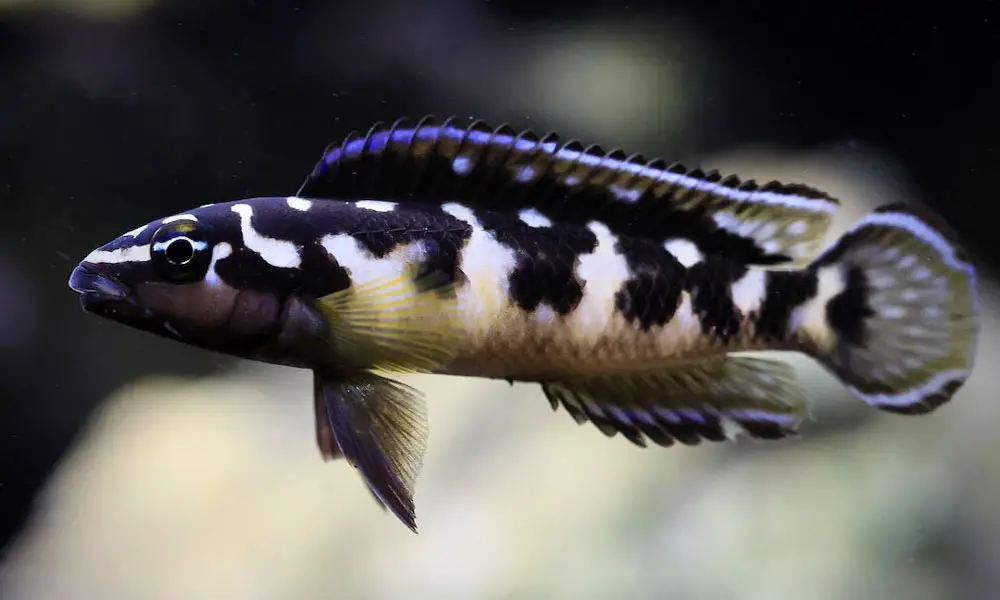
Another popular little cichlid from Lake Tanganyika. This attractive 2.8-inch (7 cm) species has a silver, torpedo-shaped body covered with irregular darker bars. Several color variations are available, depending on the region from which they are collected.
The Masked Julie can be a bit shy and peaceful, making good inhabitants for a Lake Tanganyika biotope aquarium. To help them flourish, try to replicate their natural environment as much as possible. Luckily, that’s not too hard!
| Scientific Name: | Julidochromis transcriptus |
| Common Name: | Masked Julie |
| Origin: | Lake Tanganyika |
| Family: | Cichlidae |
| Size: | 2.8-inch (7 cm) |
| Social: | Semi-aggressive |
| Care: | Easy |
| Lifespan: | 5 to 8 years |
| pH: | 8.5 to 9.2 |
| Temperature: | 73 to 80 F (23 to 27 C) |
| KH: | 8 – 14 dKH |
| Diet: | Omnivore |
| How Many Fish in A 20 Gallon Tank? | Singly or A pair |
#13 Pea Puffer (Carinotetraodon travancoricus)
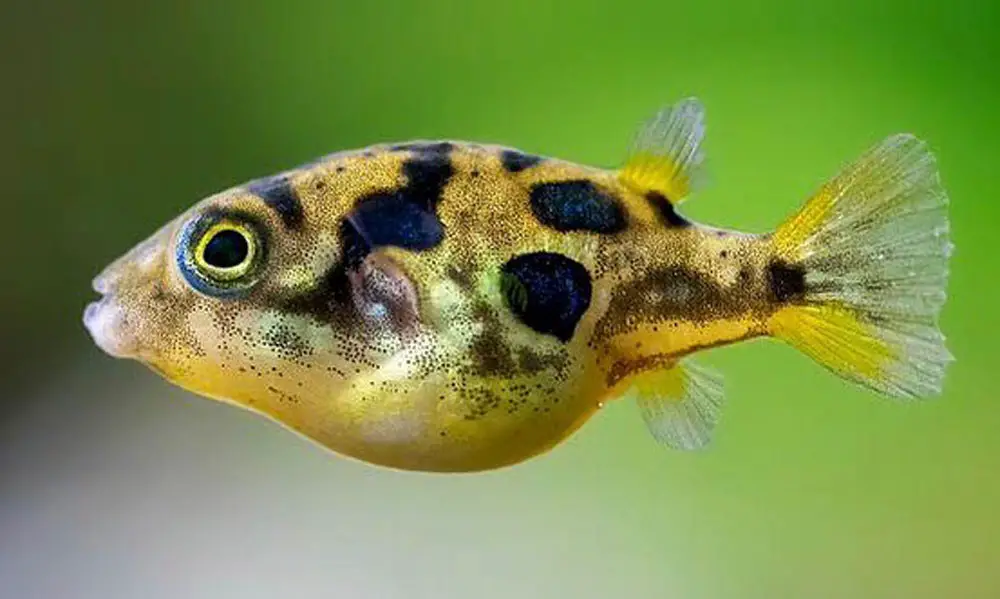
Pea Puffers are some of the most oddball aquatic creatures you can keep in a smaller-sized nano aquarium. Also known as the Indian dwarf puffer, pygmy puffer, and Malabar puffer, these adorable pufferfish are fairly new to the aquarium hobby, having gained traction only in recent years.
As one of the smallest fish on our list, they only get 1 inch (2.5 cm) long. However, this petite fish isn’t for everyone because of their aggressive nature and food requirement. Feisty males, in particular, can be a lot of work.
Given how small they are, a pair can be kept in a 10-gallon aquarium. But to make things more interesting (and less stressful), it is possible to house a group of 4-7 puffers for a 20-gallon tank. Remember to add plenty of hiding spots for the puffers to explore their territory without too much aggression.
| Scientific Name: | Carinotetraodon travancoricus |
| Common Name: | Pea Puffer, Malabar pufferfish, pygmy pufferfish, or pea pufferfish |
| Origin: | India |
| Family: | Tetraodontidae |
| Size: | 1 inch (2.5 cm) |
| Social: | Semi-aggressive |
| Care: | Advanced |
| Lifespan: | 5 years |
| pH: | 6.5 to 8.4 |
| Temperature: | 74 to 82 F (23 to 28 C) |
| KH: | 5 – 15 dKH |
| Diet: | Omnivore |
| How Many Fish in A 20 Gallon Tank? | 4 to 7 |
#14 Kuhli Loach (Pangio kuhlii)
Sometimes you may not be in the mood to keep a community tank with a school of common fish we won at a fair, or you naturally gravitate toward something more unique, then you may want to give Kuhli loach a try!
This species of eel-like fish has been kept by aquarists for over a century, and they are quite popular in the aquarium hobby as a great clean-up crew member. They are easily recognizable due to their blackish-brown body with tannish-yellow vertical bands.
These nocturnal bottom dwellers grow up to 4 inches (10 cm) in length when they reach maturity. The good news is they do not produce much waste and are quite peaceful. Therefore, I recommend keeping 3 to 6 of them in a 20-gallon tank with plenty of hiding spots so that they feel safe enough to explore.
| Scientific Name: | Pangio kuhlii |
| Common Name: | Kuhli loaches |
| Origin: | Indonesia |
| Family: | Cobitidae |
| Size: | 4 inches (10 cm) |
| Social: | Peaceful |
| Care: | Easy |
| Lifespan: | up to 10 years |
| pH: | 5.5 to 6.5 |
| Temperature: | 75 to 86 F (24 to 30 C) |
| KH: | 0 – 5 dKH |
| Diet: | Omnivore |
| How Many Fish in A 20 Gallon Tank? | 3 to 6 |
#15 Marbled Hatchetfish (Carnegiella strigata)
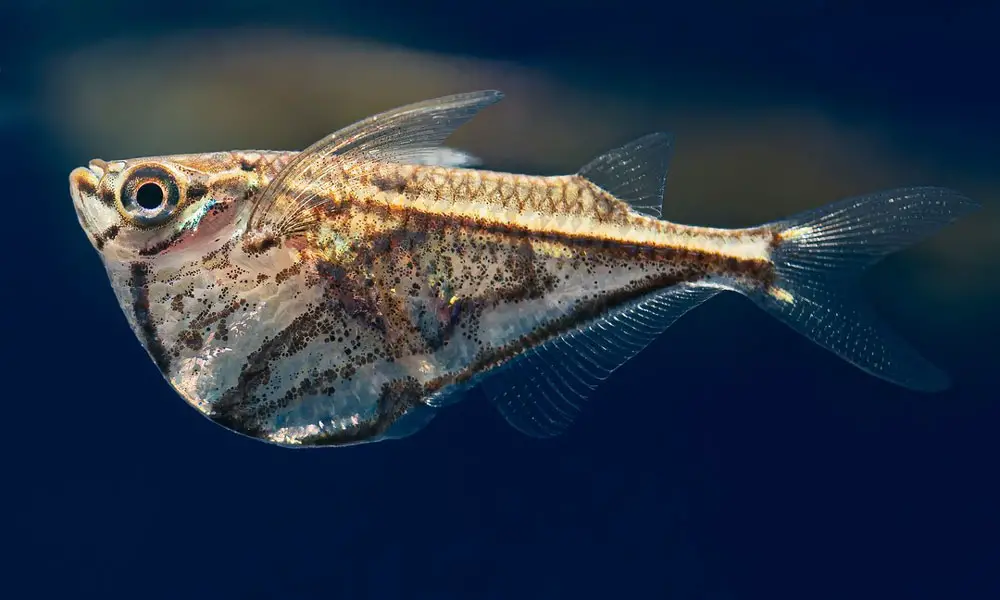
The Marbled Hatchetfish (Carnegiella strigata) is an advanced and nano fish species that can also be difficult to find in the aquarium trade. Usually, they are only relished by veteran fish keepers since they have very specialized diet requirements.
It’s not hard to see why they are so popular. Their unique and eye-catching body shape is like none other in the fish world! They are compressed-bodied, and the curved low profile makes them look like a hatchet.
As one of the most surface dwellers in this list, they like to drift along the water surface with their wing-like fins looking for tiny foods. They are also avid jumpers if frightened, so be sure to have a tight-fitting lid on the aquarium.
At one inch (2.5 cm) long, this hatchetfish is best kept in groups of at least six fish in a very peaceful 20-gallon community or species-only tank.
| Scientific Name: | Carnegiella strigata |
| Common Name: | Marbled Hatchetfish |
| Origin: | South America |
| Family: | Gasteropelecidae |
| Size: | 1 inch (2.5 cm) |
| Social: | Semi-Aggressive |
| Care: | Intermediate |
| Lifespan: | up to 5 years |
| pH: | 5.5 to 7.5 |
| Temperature: | 75 to 82 F (24 to 28 C) |
| KH: | 2 – 20 dGH |
| Diet: | Omnivore |
| How Many Fish in A 20 Gallon Tank? | 6 |
#16 Spotted Blue Eye Rainbowfish (Pseudomugil gertrudae)
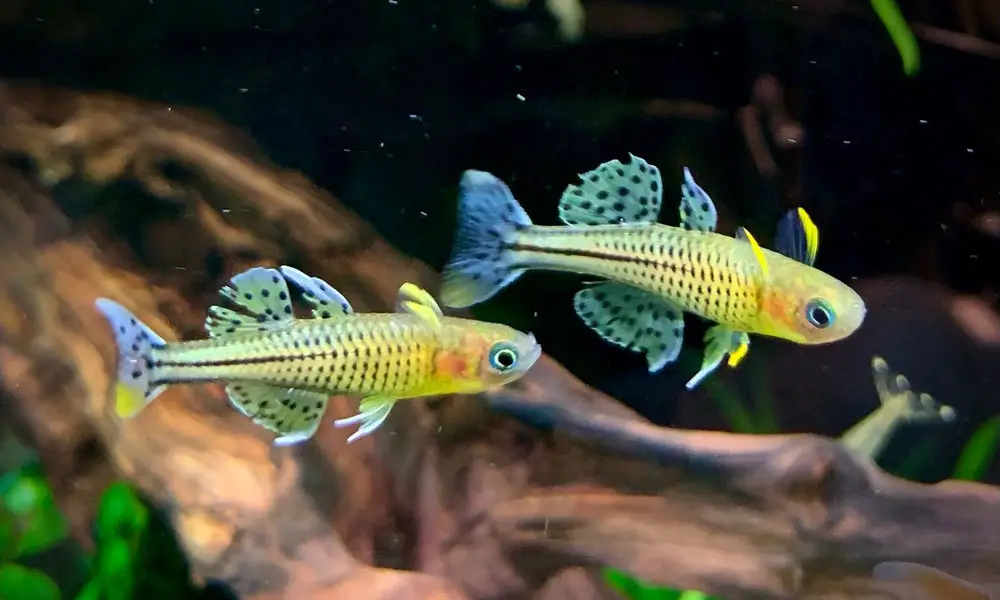
Finally, we have a rainbowfish on our list. These stunning nano fish are native to Papua New Guinea and northern Australia. They are worth getting if you find them because of their petite size (around 1.5 inches) and very vibrant appearance when they spread their colorful, ornate fins in display.
As with most rainbowfishes, we like to keep these active, peaceful but timid shoaling fish in half dozen in planted single-species aquariums. Dwarf shrimp and other non-aggressive invertebrates are great companions.
| Scientific Name: | Pseudomugil gertrudae |
| Common Name: | Spotted Blue Eye Rainbowfish |
| Origin: | Indonesia, New Guiniea, and Australia |
| Family: | Pseudomugilidae |
| Size: | 1.5 inches (4 cm) |
| Social: | Peaceful |
| Care: | Easy |
| Lifespan: | up to 5 years |
| pH: | 4.5 to 7.5 |
| Temperature: | 75 to 82 F (24 to 28 C) |
| KH: | 12 – 15 dKH |
| Diet: | Omnivore |
| How Many Fish in A 20 Gallon Tank? | 6 |
Are They the Fish for You?
So there you have it, the five best centerpiece fish for your 20-gallon tank! With such a wide variety of colors and personalities, there’s sure to be a perfect fit for every aquarium owner.
Do you have a favorite centerpiece fish? Let us know in the comments below!
